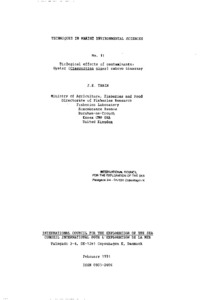| dc.contributor.author | Thain, J. E. | |
| dc.date.accessioned | 2019-01-15T23:16:22Z | |
| dc.date.available | 2019-01-15T23:16:22Z | |
| dc.date.issued | 1991 | |
| dc.identifier.citation | Thain, J. E. (1991) Biological effects of contaminants: Oyster (Crassostrea gigas) embryo bioassay. ICES Techniques in Marine Environmental Sciences, No. 11, 12pp. DOI: http://dx.doi.org/10.25607/OBP-247 | en_US |
| dc.identifier.issn | 0903–2606 | |
| dc.identifier.uri | http://hdl.handle.net/11329/690 | |
| dc.identifier.uri | http://dx.doi.org/10.25607/OBP-247 | |
| dc.description.abstract | The
oyster
embryo
bioassay
was
initially
developed
by
Woelke
(1972).
The
Ministry
of
Agriculture,
Fisheries
and
Food
(MAFF)
in
the
UK
have
modified
the
method
to
improve
the
accuracy
of
the
test
and
allow
its
use
on
board
research
vessels.
This
paper
describes
the
modified
method
which
has
been
used
to
obtain
a measure
of
the
deterioration
in
biological
water
quality
in
UK
coastal'
areas
receiving
anthropogenic
discharges.
MAFF
have
successfully
used
this
protocol
since
1976
(see
Lloyd
and
Thain,
1981;
HMSO,
1982;
Thain
and
Watts,
1984;
Byrne
et
al.,
1985;
Utting
and
Helm,
1985;
Byrne
et
al.,
1986;
Law
et
al.,
1986;
Byrne
et
al.,
1988).
The
phrase
"deterioration
in
biological
water
quality"
implies
that
a
change
in
chemical,
physical,
and/or
biological
composition
has
occurred
which
is
potentially
harmful
to
aquatic
organisms.
A
bioassay
to
measure
such
a
deterioration
should
be
based
on
a
response
by
an
organism
which
clearly
represents
a harmful
effect
at
both
the
individual
and
the
population
level
of
organization.
The
lowest
level
at
which
such
responses
can
be
measured
with
certainty
are
the
three
'scopes'
for
activity,
growth,
and
reproduction.
The
organism
response
used
in
this
bioassay
is
the
ability
of
the
oyster
embryo
to
develop
normally
and
reach
the
'D'-shaped
larval
stage
(at
which
the
paired
hinged
shells
can
be
seen)
within
24
hours.
Although
the
exposure
time
is
short,
it
encompasses
a
period
of
intense
cellular
activity
during
which
the
impairment
of
a number
of
critical
physiological
and
biochemical
processes
may
result
in
poor
growth
and
development.
The
response
measured
is,
therefore,
similar
to
that
used
in
other
early
life
stage
tests
which
record
growth
and
development,
and
it
has
the
advantage
that
exogenous
feeding
is
not
required,
thus
eliminating
this
source
of
variation
in
the
test
results. | |
| dc.language.iso | en | en_US |
| dc.publisher | International Council for the Exploration of the Sea (ICES) | en_US |
| dc.relation.ispartofseries | ICES Techniques in Marine Environmental Sciences; 11 | |
| dc.title | Biological effects of contaminants: Oyster (Crassostrea gigas) embryo bioassay. | en_US |
| dc.type | Report | en_US |
| dc.description.status | Published | en_US |
| dc.format.pages | 12pp. | en_US |
| dc.bibliographicCitation.conferencename | | |
| dc.description.refereed | Refereed | en_US |
| dc.publisher.place | Copenhagen, Denmark | en_US |
| dc.description.currentstatus | Current | en_US |
| dc.description.sdg | 14.1 | |
| dc.description.bptype | Standard Operating Procedure | en_US |
| dc.description.bptype | Guide | en_US |
| obps.contact.contactemail | info@ices.dk | |
| obps.resourceurl.publisher | http://ices.dk/publications/library/ | en_US |
 Repository of community practices in Ocean Research, Applications and Data/Information Management
Repository of community practices in Ocean Research, Applications and Data/Information Management
